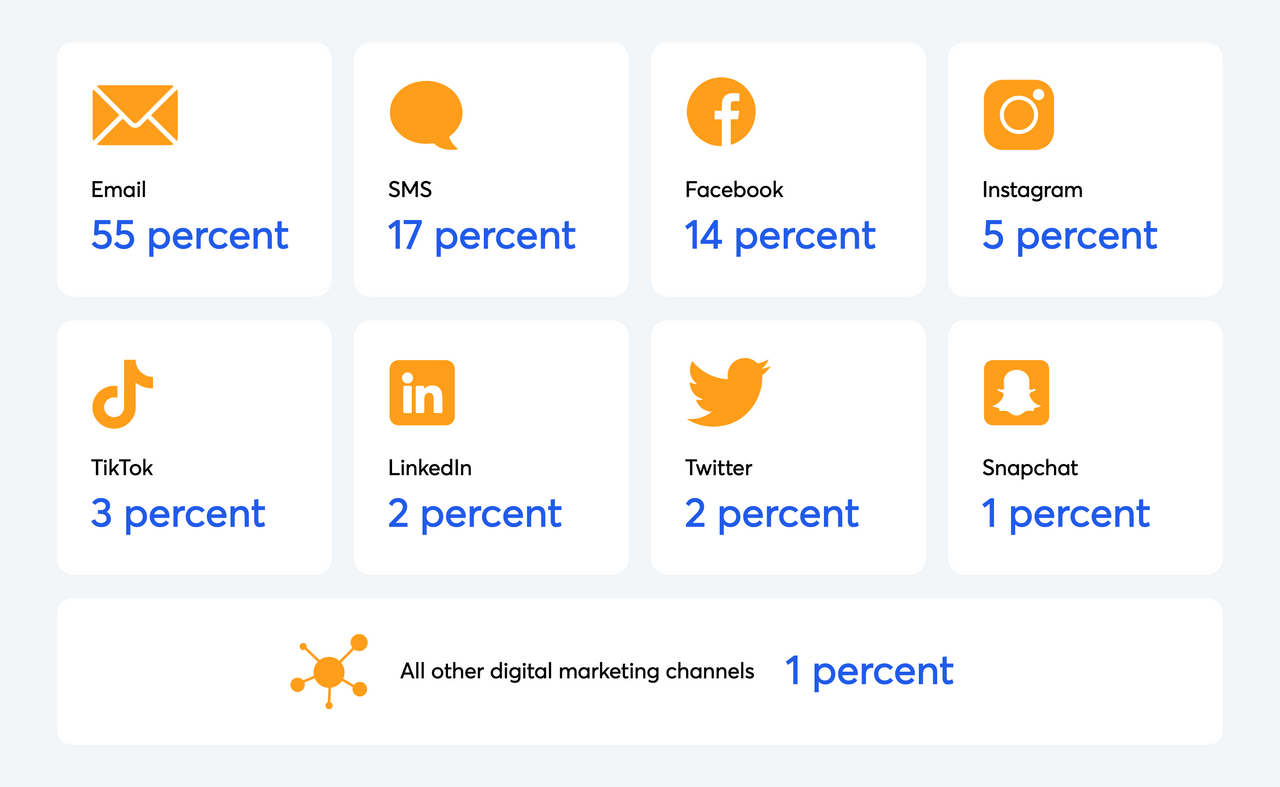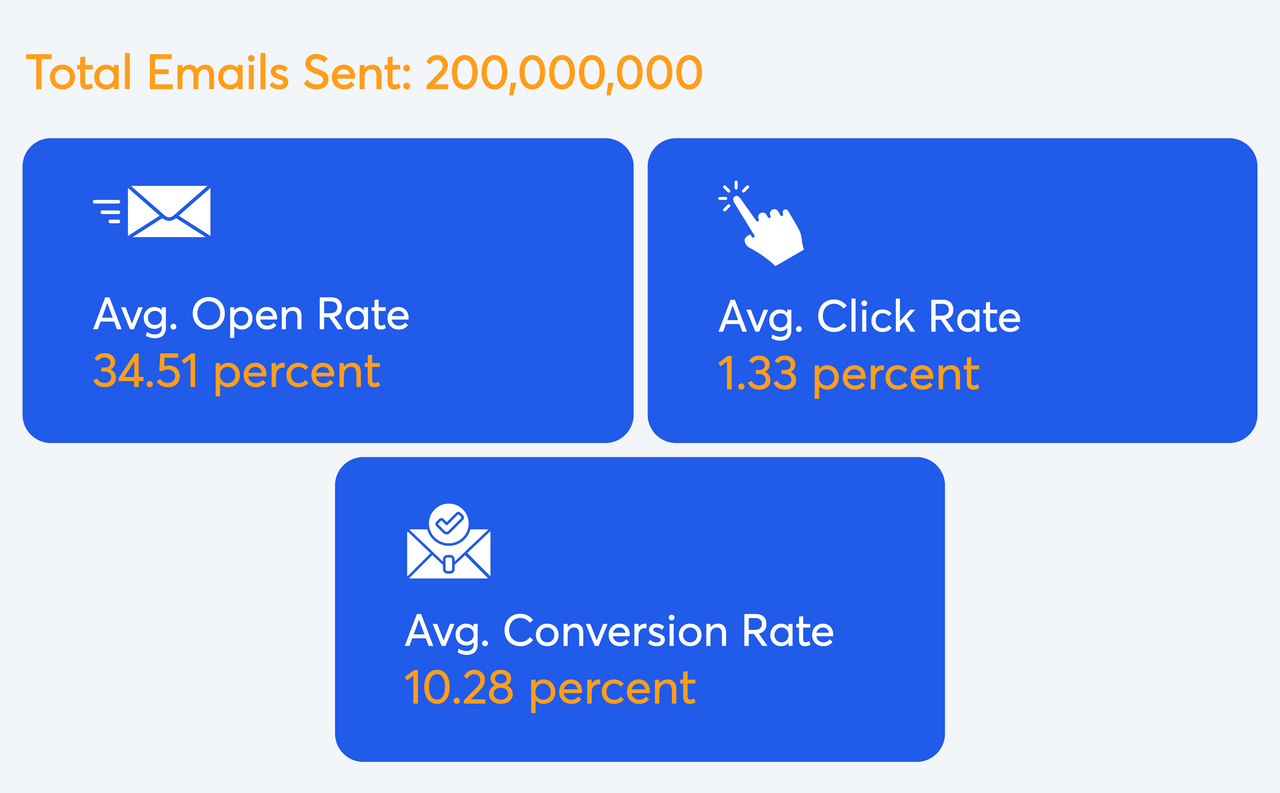
For decades, email marketing has been among the best ways for businesses to get the word out, with easily understood success metrics and a high return on investment. Whether you have just a handful of email addresses or a robust contact list of loyal customers, email is a logical, easy place to start your regular outreach and communication efforts.
While social media and SMS text marketing have risen in the ranks over the last few years, small businesses often find that email marketing provides a solid foundation for those efforts, with a higher rate of engagement and return. In fact, 55 percent of people prefer email as their #1 way to hear from businesses and nonprofits, outranking text messaging, social media and other methods of digital communication.
Let’s take a look at email marketing by the numbers to understand how businesses are using it and how consumers respond to it.
Key Takeaways
- More than 90 percent of survey respondents say email marketing is important to their company’s overall success.
- Email is considered one of the most effective channels for marketing, with 79 percent of marketers placing it in their top 3.
- The global market for email marketing software was worth $7.5 billion in 2020. By 2027, it is estimated to reach $17.9 billion.
- More than half the world’s population (over 4.2 billion people) were active email users globally in 2022. By the end of 2026, that figure is projected to go over 4.7 billion.
- 55 percent of consumers say email is their preferred digital channel for business communication.
- Brands made $36 for every U.S. dollar they spent on email marketing.
- The average open rate for 200 million emails sent among Constant Contact customers was 34.51 percent, the average click rate among all delivery was 1.33 percent, and the average bounce rate was 10.28 percent.
General email marketing statistics and trends
What’s the main reason companies should consider email marketing? Well, because email marketing is effective. But it’s important to understand how your competition is using email, and how your audience is consuming email, in order to make sure you stand out in the inbox every time.
Most businesses consider email marketing a key element to their success
More than 90 percent of businesses say email marketing is important to their company’s overall success. 41 percent say it’s very vital—up nearly 30 percent since before the pandemic in 2019. Hence, email is considered one of the most effective channels for marketing, with 79 percent of marketers placing it in their top 3 (and customers ranking it as #1!)
Email marketing revenue is growing
By 2027, the worldwide email marketing market will be worth 17.9 billion dollars, up from its 2020 valuation of 7.5 billion dollars. Even the most skeptical ecommerce companies become enthusiastic email marketing practitioners in the face of this startling statistic.
Email marketing revenue worldwide over the years
The number of email users and emails exchanged is continuously increasing
More than half the world’s population (over 4.2 billion people) were active email users globally in 2022. By the end of 2026, that figure is projected to go over 4.7 billion. Knowing this, many businesses utilized email marketing strategies reaching a whopping 319 billion business and consumer emails sent and received daily. This number is anticipated to increase to more than 376 billion emails exchanged daily in the next four years.
The number of emails sent and received each day globally
Email marketing has proven to offer a great return on investment (ROI)
In order to determine whether your marketing efforts are working or not, it’s important to evaluate your return on investment by taking a careful look at how your contacts are engaging with your emails– particularly when it comes to purchasing products or donating to a cause.
When it comes to email marketing, companies make an average of $36 for every U.S. dollar they spend on email marketing. Among many industries, the retail, ecommerce, and consumer goods business had the highest return on investment (ROI), at $45.
Email is the preferred channel for digital business communications
According to the Constant Contact Small Business Now report, 55 percent of consumers who want to keep up-to-date with businesses they support say that email is their most preferred means of communication, far outpacing other methods like text messaging and social platforms.
SMS was preferred by 17 percent of these consumers, with Facebook coming in at 14 percent ahead of all other social platforms, and the full breakdown shows just how strong these preferences are:

Nonetheless, one out of ten people have changed their preferences in the past years and now favor text messaging over social media and email.
Email marketing as a communication channel for businesses
Email marketing has demonstrated benefits for small business owners, from building the credibility of your brand to increasing sales.
Email is a quick and efficient way to communicate with your audience
34 percent of consumers are more likely to purchase from email marketing, and 21 percent of emails are typically opened within the first hour. Out of the received emails, consumers are more likely to buy from emails that include a coupon or discount (67 percent), check-in with consumers (33 percent), and business updates (28 percent).
Types of emails consumers are more likely to buy from

Your consumers likely use email; therefore, you should too
No matter what your company is, email marketing gives you the ability to connect with customers wherever they are. 60 percent of consumers say they’ve purchased as a result of a marketing email they received.
Knowing your audience better can be achieved by developing a customer avatar
This in-depth investigation of your target market covers their interests, passions, and objectives. This is significant since 71 percent of consumers prefer to purchase products from companies that share their values. Because it’s challenging to forge that kind of emotional bond with a bigger company, 71 percent of respondents said they value the experience offered by small businesses.
There are various emails marketers can send depending on their audience and purpose
While many factors impact email marketing success, the two key players are the welcome email and newsletter.
Types of emails marketers send:
Personalization – a way to stand out
As the competition keeps growing, businesses should seek a way to grab the buyer’s attention. This is where personalization comes in handy.
In 2021, more than half (55 percent) of businesses were boosting personalization as an email marketing strategy
9 in 10 marketers believed personalization is crucial to overall business strategy since 80 percent of customers are likely to purchase from a brand that provides personalized experiences.

Buyers expected more personalized attention from marketers
76 percent of buyers expected more personalized attention to develop an intimate relationship with your brand. Most (83 percent) customers were willing to share their data to create a more personalized experience.
The best way to personalize your emails is with profile data or by customer segment
4 out of 5 marketers personalized emails with profile data and 64 percent personalized them by customer segment. However, there are also other ways to achieve this goal. Here is the list of approaches you can use.
Top 10 elements used to personalize marketing emails
Segmented email marketing campaigns drive more open and click-through rates.
Segmented email campaigns drive 30 percent more opens and 50 percent more click-throughs than untargeted ones.
Email marketing open rates, click-through rates and bounce rates

As the name suggests, email open rates describe the frequency with which your recipients open your emails– but some email service providers (ESPs) provide privacy measures that can obscure or skew your open rates, so tracking other metrics is critical. Your click rate, for example, is a percentage of how many successfully delivered emails got at least one click. This number shows if your audience finds your emails relevant enough to click through and check for more. And speaking of successfully delivered, your bounce rate shows how many emails did not get delivered– and managing your email deliverability is just as important as your other benchmarks.
When establishing your email marketing benchmarks, consider your average open rate, click rate and bounce rate.
Periodically, we gather and examine the data from over 200 million emails sent from Constant Contact customers to look at average open rates, click rates and bounce rates across industry.
According to our research from December 2022, the average open rate across 200 million emails was 34.51 percent, the average click rate was 1.33 percent, and the average bounce rate was 10.28 percent.

The sectors with the best performance overall are faith-based and other nonprofit organizations
Of the businesses who identified their industries in our benchmarking research, faith-based organizations come out in front with an average open rate of 43.36 percent and an average click rate of 2.28 percent. Their bounce rate is also lower than the average at 8.77 percent.
Among for-profit senders, child care service providers boast above-average performance, with an average open rate of 42.60 percent, a click rate of 1.61 percent and a bounce rate of 9.20 percent.
The average open rate for retail senders, including brick and mortar, online, wholesalers and direct selling, was 33.11 percent with a click rate of 0.88 percent.
Thursday is the best day of the week to send a marketing email
It is important to look further and consider the preferences of your intended audience. This is a crucial step since you might find that your members spend most of their online time on the weekends or at night. According to data amalgamated from a number of sources, Thursday is the ideal day to send an email, with Tuesday following close behind.
The subject line has a significant impact on the open email rate
Almost half (47 percent) of email users read emails based only on the subject line, while 69 percent of email recipients flag them as spam. Emails without a subject line collectively have an open rate of 8 percent higher than emails with one, while emails with personalized subject lines have an open rate of 22 percent higher.
To wrap things up
Email marketing is a value-rich channel to promote your small business, as evidenced by the above statistics. Whether you’re just starting out or already have a strong strategy, email marketing can give you the tools to reach, engage and expand your audience..




